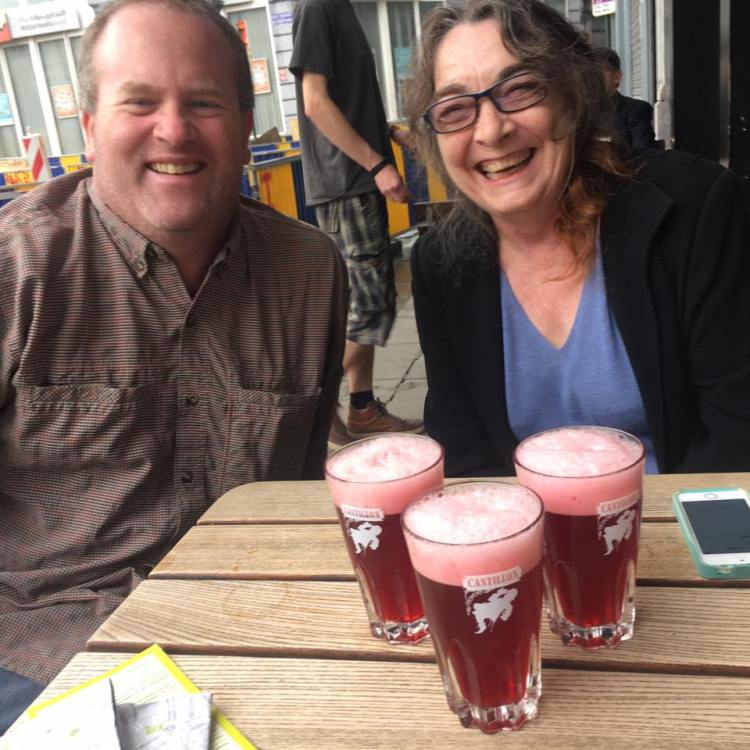As part of our “Field Trip” series, we’re following Avenue Pub owner Polly Watts and her staff as they get up close and personal with some of the best beer in Belgium. Next up: Polly Watts tours battlefields and a historic brewery tied to war.
I joke that when I travel, beer and battlegrounds are my favorite activities. The social aspect of beer and the history of the region as told through war memorials are the two aspects of travel that I seem to return to every time I travel. My memories of the Poperings/Yrpes region of Belgium combine those about as much as is possible, so of course I wanted the Pub staff to see the area.
Poperings historically has been a farming region and it the major area in Belgium for hops. Yrpes (pronounced “eeper”) and its surrounding area are the site of the bloody four-year Battle of Passchendale during World War I. Almost half a million souls were lost during those four years in the miserable stalled trench battle that completely consumed the terrain. The fields of crops are so dotted with cemeteries that one doesn’t even have to go to the major sites and cemeteries surrounding the Menin Gate to see the inspiration for John McCrae’s WWI poem “In Flanders Fields”:
In Flanders fields the poppies blow
Between the crosses, row on row
That mark our place, and in the sky
The larks, still bravely singing, fly,
Scarce heard amid the guns below.
We are the dead; short days ago
We lived, felt dawn, saw sunset glow,
Loved and were loved, and now we lie In Flanders fields.
Take up our quarrel with the foe!
To you from failing hands we throw
The torch; be yours to hold it high!
If ye break faith with us who die
We shall not sleep, though poppies grow
In Flanders fields.”
Pleas for future peace are everywhere, in the German Youth Brigade cemeteries where the remains of thousands of young student and seniors soldiers lay buried in a mass grave, in the countryside memorial to the first gas attack the world had ever seen, and at the Menin Gate, the memorial that every night still plays last post to honor the dead of the war. I do not possess the eloquence to fully explain the emotion of this place, but it’s abundantly clear after visiting why people at the time thought it was “the War to End All Wars.”
The history of this place is intertwined with the brewery we visited. The owner of Van Eecke is descended from medieval brewers in the region. The locals burned the original brewery to the ground to keep the advancing Germans from occupying it. After all, providing beer-brewing equipment to the enemy would we a real disaster.
Philip’s (the Van Eecke owner) grandfather and great uncle were both involved and in the war. One of the many roadside memorials we visited was a statue of Philip’s great uncle, who died during one of the battles towards the end of the war.
After the war, Philip’s father rebuilt the brewery within sight of the Salient Line. Like everything in the area, the building dates to 1924. Yrpes and surrounding areas were pummeled by four years of mortar attacks. What you see there today are detailed reconstructions of the original medieval buildings.
After the war Philip’s grandfather met the daughter of an the local brewery at the Brewers Ball, and two brewing families turned into one family with two breweries.
Today, Van Eecke is a medium-size regional brewery. Like many regional breweries, their local community supports and their signs are on many local pubs and restaurants. This is such a change from Brussels, where you see signs of mostly InBev products like Jupilar with a smattering of Duvel Moortgat. Their beers use local hops and their Poperings Hommel is a much hoppier Belgian beer than you normally see in these regional breweries. Our Pub Pils is the Pilsner the brewery makes for the local pubs.
The house where Philip grew up was built on the brewery grounds. Again, this is typical. Brewery owners lived where they worked. Our group of 10 was served coffee in the house on his mother’s china, surrounded by antiques overlooking the small garden. Not surprisingly, all the windows in the light-filled rooms face away from the breweries grounds, so once inside you don’t feel its presence.
It’s doesn’t take much to visualize the generations of brewers who were raised here with the brewery courtyard as their playground. The rabbit warren of brewing buildings that have been added on over the years would have been the best hide-and-seek a kid could be tempted with, so one also wonders how the matriarch of the family kept the kids from disappearing into that of stairs and little rooms.
Five years ago, Philip introduced me to what still ranks in my experience as the best beer restaurant I’ve visited. T’T Hommelhof is in the Watou Village square, a town of no more than 2,000 people. Although normally closed on Tuesday, the chef opened us just for our group, a testimony to the close relationships they have with our host Van Eecke. The food and beer the chef creates feel organically connected. These are not “pairings” where a modern chef has created a dish and then found a beer to accompany it. They are such seamless and delicious combination that one leaves with the idea that neither could exist without the other — which is very much like the relationship between the history of the region and the brewery.







 As part of our “
As part of our “
 “Open 24/7 except when we are in Belgium”
“Open 24/7 except when we are in Belgium”